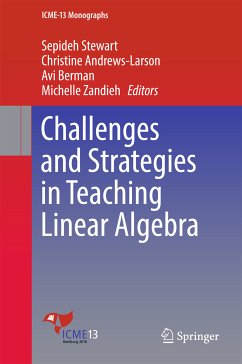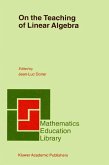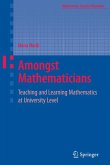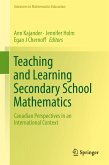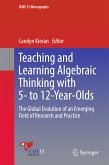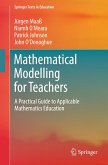Challenges and Strategies in Teaching Linear Algebra (eBook, PDF)
Redaktion: Stewart, Sepideh; Zandieh, Michelle; Berman, Avi; Andrews-Larson, Christine
72,95 €
72,95 €
inkl. MwSt.
Sofort per Download lieferbar

36 °P sammeln
72,95 €
Als Download kaufen

72,95 €
inkl. MwSt.
Sofort per Download lieferbar

36 °P sammeln
Jetzt verschenken
Alle Infos zum eBook verschenken
72,95 €
inkl. MwSt.
Sofort per Download lieferbar
Alle Infos zum eBook verschenken

36 °P sammeln
Challenges and Strategies in Teaching Linear Algebra (eBook, PDF)
Redaktion: Stewart, Sepideh; Zandieh, Michelle; Berman, Avi; Andrews-Larson, Christine
- Format: PDF
- Merkliste
- Auf die Merkliste
- Bewerten Bewerten
- Teilen
- Produkt teilen
- Produkterinnerung
- Produkterinnerung

Bitte loggen Sie sich zunächst in Ihr Kundenkonto ein oder registrieren Sie sich bei
bücher.de, um das eBook-Abo tolino select nutzen zu können.
Hier können Sie sich einloggen
Hier können Sie sich einloggen
Sie sind bereits eingeloggt. Klicken Sie auf 2. tolino select Abo, um fortzufahren.

Bitte loggen Sie sich zunächst in Ihr Kundenkonto ein oder registrieren Sie sich bei bücher.de, um das eBook-Abo tolino select nutzen zu können.
Provides an overview of current research on the nature of difficulties and students' thought processes in the context of learning linear algebra
Discusses the use of technology in teaching and learning linear algebra
Offers practical advice on how to improve student engagement in linear algebra courses
- Geräte: PC
- ohne Kopierschutz
- eBook Hilfe
- Größe: 6.85MB
Andere Kunden interessierten sich auch für
![On the Teaching of Linear Algebra (eBook, PDF) On the Teaching of Linear Algebra (eBook, PDF)]() On the Teaching of Linear Algebra (eBook, PDF)167,95 €
On the Teaching of Linear Algebra (eBook, PDF)167,95 €![A 3D Visualization Teaching-Learning Trajectory for Elementary Grades Children (eBook, PDF) A 3D Visualization Teaching-Learning Trajectory for Elementary Grades Children (eBook, PDF)]() Jacqueline SackA 3D Visualization Teaching-Learning Trajectory for Elementary Grades Children (eBook, PDF)40,95 €
Jacqueline SackA 3D Visualization Teaching-Learning Trajectory for Elementary Grades Children (eBook, PDF)40,95 €![Amongst Mathematicians (eBook, PDF) Amongst Mathematicians (eBook, PDF)]() Elena NardiAmongst Mathematicians (eBook, PDF)80,95 €
Elena NardiAmongst Mathematicians (eBook, PDF)80,95 €![Teaching and Learning Secondary School Mathematics (eBook, PDF) Teaching and Learning Secondary School Mathematics (eBook, PDF)]() Teaching and Learning Secondary School Mathematics (eBook, PDF)128,95 €
Teaching and Learning Secondary School Mathematics (eBook, PDF)128,95 €![Teaching and Learning Algebraic Thinking with 5- to 12-Year-Olds (eBook, PDF) Teaching and Learning Algebraic Thinking with 5- to 12-Year-Olds (eBook, PDF)]() Teaching and Learning Algebraic Thinking with 5- to 12-Year-Olds (eBook, PDF)136,95 €
Teaching and Learning Algebraic Thinking with 5- to 12-Year-Olds (eBook, PDF)136,95 €![International Perspectives on the Teaching and Learning of Geometry in Secondary Schools (eBook, PDF) International Perspectives on the Teaching and Learning of Geometry in Secondary Schools (eBook, PDF)]() International Perspectives on the Teaching and Learning of Geometry in Secondary Schools (eBook, PDF)88,95 €
International Perspectives on the Teaching and Learning of Geometry in Secondary Schools (eBook, PDF)88,95 €![Mathematical Modelling for Teachers (eBook, PDF) Mathematical Modelling for Teachers (eBook, PDF)]() Jürgen MaaßMathematical Modelling for Teachers (eBook, PDF)60,95 €
Jürgen MaaßMathematical Modelling for Teachers (eBook, PDF)60,95 €-
-
-
Provides an overview of current research on the nature of difficulties and students' thought processes in the context of learning linear algebra
Discusses the use of technology in teaching and learning linear algebra
Offers practical advice on how to improve student engagement in linear algebra courses
Discusses the use of technology in teaching and learning linear algebra
Offers practical advice on how to improve student engagement in linear algebra courses
Dieser Download kann aus rechtlichen Gründen nur mit Rechnungsadresse in A, B, BG, CY, CZ, D, DK, EW, E, FIN, F, GR, HR, H, IRL, I, LT, L, LR, M, NL, PL, P, R, S, SLO, SK ausgeliefert werden.
Produktdetails
- Produktdetails
- Verlag: Springer International Publishing
- Seitenzahl: 382
- Erscheinungstermin: 1. Februar 2018
- Englisch
- ISBN-13: 9783319668116
- Artikelnr.: 52943964
- Verlag: Springer International Publishing
- Seitenzahl: 382
- Erscheinungstermin: 1. Februar 2018
- Englisch
- ISBN-13: 9783319668116
- Artikelnr.: 52943964
- Herstellerkennzeichnung Die Herstellerinformationen sind derzeit nicht verfügbar.
Contents.- .- Part I. Theoretical Perspectives Elaborated through Tasks.- The Learning and Teaching of Linear Algebra through the Lenses of Intellectual Need and Epistemological Justification and Their Constituents.- .- Learning Linear Algebra Using Models and Conceptual Activities .- .- Moving between the embodied, symbolic and formal worlds of mathematical thinking with specific linear algebra tasks.- .- Part II. Analyses of Learners' Approaches and Resources.- Systems of linear equations - a key element in the learning of Linear Algebra.- .- Rationale for Matrix Multiplication in Linear Algebra Textbooks.- .- An Action Process Object Schema (APOS) analysis of the understanding of determinants of matrices by Zimbabwean undergraduate mathematics students.- .- Difficulties associated with understanding the concept of vector subspace: A case study of Zimbabwean teachers.- .- Stretch Directions and Stretch Factors: A Sequence Intended to Support Guided Reinvention of Eigenvector and Eigenvalue Stretch Directions and Stretch Factors: A Sequence Intended to Support Guided Reinvention of Eigenvector and Eigenvalue.- .- .- Examining Students' Procedural and Conceptual Understanding of Eigenvectors and Eigenvalues in the Context of Inquiry-Oriented Instruction.- Part III. Dynamic Geometry Approaches.- Mental Schemes of Linear Algebra Visual Constructs.- How DGS mediates students' reasoning on 3D linear transformations: a combined analysis from thinking modes and semiotic perspectives.- .- Fostering Students' Competences in Linear Algebra with digital Resources .- Part IV. Challenging tasks with pedagogy in mind .- Linear Algebra-a Companion of Advancement in Mathematical Comprehension.- .- An algebraic/computational approach to systems of linear equations in a Linear Algebra Course for students of computer science, physics, and mathematics.- .- Nonnegative Factorisationof a Data Matrix as a Motivational Example for Basic Linear Algebra.- .- Motivating Examples, Meaning and Context in Teaching Linear Algebra.- .- Holistic Teaching and Learning Holistically, exemplified through one example from Linear Algebra.- .- Using Challenging problems in Teaching Linear Algebra
Contents.- .- Part I. Theoretical Perspectives Elaborated through Tasks.- The Learning and Teaching of Linear Algebra through the Lenses of Intellectual Need and Epistemological Justification and Their Constituents.- .- Learning Linear Algebra Using Models and Conceptual Activities .- .- Moving between the embodied, symbolic and formal worlds of mathematical thinking with specific linear algebra tasks.- .- Part II. Analyses of Learners' Approaches and Resources.- Systems of linear equations - a key element in the learning of Linear Algebra.- .- Rationale for Matrix Multiplication in Linear Algebra Textbooks.- .- An Action Process Object Schema (APOS) analysis of the understanding of determinants of matrices by Zimbabwean undergraduate mathematics students.- .- Difficulties associated with understanding the concept of vector subspace: A case study of Zimbabwean teachers.- .- Stretch Directions and Stretch Factors: A Sequence Intended to Support Guided Reinvention of Eigenvector and Eigenvalue Stretch Directions and Stretch Factors: A Sequence Intended to Support Guided Reinvention of Eigenvector and Eigenvalue.- .- .- Examining Students' Procedural and Conceptual Understanding of Eigenvectors and Eigenvalues in the Context of Inquiry-Oriented Instruction.- Part III. Dynamic Geometry Approaches.- Mental Schemes of Linear Algebra Visual Constructs.- How DGS mediates students' reasoning on 3D linear transformations: a combined analysis from thinking modes and semiotic perspectives.- .- Fostering Students' Competences in Linear Algebra with digital Resources .- Part IV. Challenging tasks with pedagogy in mind .- Linear Algebra-a Companion of Advancement in Mathematical Comprehension.- .- An algebraic/computational approach to systems of linear equations in a Linear Algebra Course for students of computer science, physics, and mathematics.- .- Nonnegative Factorisationof a Data Matrix as a Motivational Example for Basic Linear Algebra.- .- Motivating Examples, Meaning and Context in Teaching Linear Algebra.- .- Holistic Teaching and Learning Holistically, exemplified through one example from Linear Algebra.- .- Using Challenging problems in Teaching Linear Algebra
